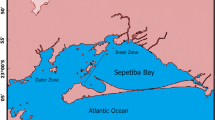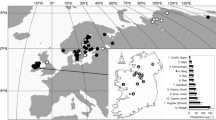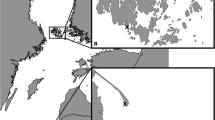Abstract
The isopod Munnopsurus atlanticus occupies bathyal depths in both the Bay of Biscay (NE Atlantic; between 383 and 1022 m) and in the Catalan Sea (Northwestern Mediterranean; between 389 and 1859 m). The species was dominant in both assemblages, reaching bathymetric peaks of abundance on the upper part of the continental slope (400 m depth) in the Bay of Biscay and at ˜600 m in the Catalan Sea. Both the Atlantic and the Mediterranean populations are bivoltines. Demographic analysis of the Bay of Biscay population revealed the production of two generations per year with different potential longevity (5 mo for G1 and 11 mo for G2). The mean cohort-production interval (CPI) was estimated at 8 mo, and results of the demographic analysis were also used to estimate production for the Catalan Sea populations. Mean annual density (D) and biomass (B) were higher in the Bay of Biscay (D = 356.7 individuals 100 m−2; B = 0.803 mg dry wt m−2 yr−1) than in the Mediterranean (D = 16.3 individuals 100 m−2; B = 0.078 mg dry wt m−2 yr−1). Also, mean annual production was an order of magnitude higher in the Atlantic (between 4.063 and 4.812 mg dry wt 100 m−2 yr−1 depending on the method used) than in the Catalan Sea (between 0.346 and 0.519 mg dry wt 100 m−2 yr−1). M. atlanticus feeds on a wide variety of benthic and pelagic food sources. In both study areas, phytodetritus was not important in the diet of M. atlanticus. In contrast, gut-content data suggested an indirect coupling with phytoplankton production in both areas via foraminiferans. The life history and the recorded production are considered in respect to both the dynamics and levels of primary production and the total mass flux in the respective study areas. Differences in the secondary production of both populations seemed to be more consistently explained by differences in total mass flux than by differences in the primary production levels; this is also consistent with the variety of food sources exploited by M. atlanticus.
Similar content being viewed by others
Author information
Authors and Affiliations
Additional information
Received: 22 February 1999 / Accepted: 3 February 2000
Rights and permissions
About this article
Cite this article
Cartes, J., Elizalde, M. & Sorbe, J. Contrasting life histories and secondary production of populations of Munnopsurus atlanticus (Isopoda: Asellota) from two bathyal areas of the NE Atlantic and the NW Mediterranean. Marine Biology 136, 881–890 (2000). https://doi.org/10.1007/s002270000287
Issue Date:
DOI: https://doi.org/10.1007/s002270000287




